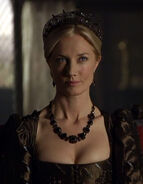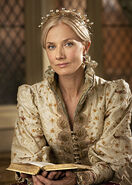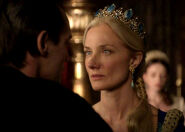"As long as His Majesty is sick, I will move my bed to his chambers, the better to look after him." - Katherine Parr explaining she will look after her royal husband when he is sick.
Catherine Parr, sometimes spelled as Katherine Parr, is the sixth and final wife of Henry Tudor VIII from 12 July 1543 to 28 January 1547, and ruled as queen regent from July to September 1544. Katherine was portrayed by english actress, Joely Richardson.
While Catherine only appeared in only the last five episodes of Season 4, she still distinguished herself as a prominent character, for not only was the duration of her reign as queen second only to Catherine of Aragon, but she was also one of the only two of Henry's wives who outlived him instead of suffering tragic fates. Like Anne of Cleves, she did not have a real relationship with Henry before they were married.
Season 4[]

Catherine Parr's relationship with Thomas Seymour.
Catherine was first introduced in the series as a wealthy, respected noblewoman; who's second husband was dying. She caught Henry's eye not long after his fifth queen, Catherine Howard was beheaded and he invited her to spend time with him and his daughters; when she came to court, during which he found her company to be truly pleasant. But at this point in Henry's life, his reputation had caught up with him in the international community. Hence, numerous kings had declined to give him their blessings to marry their daughters or female relations out of fear that they would end up either disgraced or executed. Katherine not only harboured similar concerns, but was also shown to be in a clandestine relationship with Thomas Seymour.
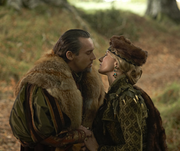
Catherine greets Henry on his return from the battlefield.
Therefore; Catherine refused Henry's implied proposal to become his queen, but once her severely-ill husband dies, she later came to believe that; god wished for her to marry the king - Henry had deliberately sent Thomas Seymour away to assume a role in foreign diplomacy. As soon as her husband died, Henry proposed again, but this time she agreed - they were married at the start of Episode 4.07. This makes her the only one of Henry's wives (besides Catherine of Aragon) to have been married before. Despite the obvious fact that; their marriage was not one of true romance, Catherine's relationship; with Henry was still one of mutual respect and affection - she; proved to be a loving step-mother to his three children and even persuaded him to; allow her to invite Elizabeth and Edward to court more often. She also helped to care for Henry tirelessly, especially as he aged and his health increasingly deteriorated; due to his leg ulcer. Henry on his part, returned her diligent efforts with genuine gratitude and her tenderness with silent yet genuine affection. In fact, his confidence in her was what made him appoint her Regent while he was at war with France, much to the dismay of some of his more authoritarian, pro-Catholic advisors, such as Bishop Gardiner and Thomas Wriothesley.
Catherine's relationships; with her three step-children was also a particularly notable feature; she pitied Edward; who unlike his older half-sisters, had been brought up suffocated; by his future responsibilities and was unable to develop his own personality because his father shut him away from the world so often. Hence, though she was prohibited from inviting him to court whenever she pleased, Catherine made the most of the times where they were; allowed to be together - treating him; with an appropriate blend of respect and tenderness that; while doing justice to his royal status, still took into account the fact that he was a growing child in need of true parental affection. In fact, it was she who later decided the time where his curls were to be cut, and he should start wearing breeches.
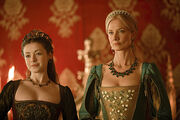
Princess Mary (left) and queen Catherine Parr (right).
Catherine also initially had an amiable relationship; with Mary; who she already knew long before she married Henry. But there was a difference between her and her older step-daughter that; later created a chasm in their relationship - Catherine held Protestant beliefs, which she concealed from Mary, for she knew that; Mary was a fanatical Catholic who held no compromises in terms of religion. When Mary herself increasingly picked up on Catherine's Protestant beliefs; which she firmly regarded as heresy and dangerous to her younger siblings, she withdrew her favour from her step-mother and privately supported Bishop Gardiner's attempts to charge her with heresy. While Catherine showed Mary no hostility over her involvement in the investigation and actually respected her for her devotion to the faith her mother raised her in, their relationship still became distant, although Mary still accepted Katherine comforting her when Henry bid them all farewell.
On the other hand, Catherine was shown to always share an intimate familial relationship; with Elizabeth; who she seemed closest to out of Henry's children. In fact, it was Catherine; who persuaded Henry to let Elizabeth have permanent lodgings at court and she later encouraged this step-daughter to look towards Protestantism, both because she herself was Protestant, and because she felt an obligation to raise Elizabeth in the faith of her deceased mother, Anne Boleyn, just as Mary was; by her mother. Interestingly, this was not the case; with Edward VI; who contributed greatly to the Protestant Reformation during his short reign, although his mother, Jane Seymour, was secretly a catholic.
Catherine's brief attempts to push Henry towards further Reformation, makeing him dangerously hostile and Catherine immediately falls; into line, and instructs her ladies not to openly discuss matters of Protestantism any further, outwardly conforming to the Church of England. Near the end of Season 4, Catherine is briefly attacked by catholic fundamentalists of the church of England for supposed heresy; which in their eyes is true; since she is a true Protestant like Anne Boleyn and Cromwell, although Henry; despite saying that; he will allow an investigation, claims he is fully resolved to spare her life. When Bishop Gardiner sends the king's chancellor, Thomas Wriothesley; with a warrant for Catherine's arrest, but she is horrified. Henry simply; allowed the arrest warrant to be delivered so that; he would have an excuse to remove Gardiner, whose fanaticism he finds disruptive and irritating. Henry furiously insults and berates the startled Wriothesley in front of the equally-confused Catherine, then has Gardiner permanently banished from court.
When Henry bids his family a loving farewell in the series finale - as he intends to separate from them before his death - Catherine holds Mary and Elizabeth's hands and weeps; with Mary, having grown to care for Henry, if not to love him romantically. Henry's final promise to Catherine is that; she may remarry to whomever she chooses after he dies and shall receive a yearly pension of 7,000 pounds.

Queen Catherine Parr (right) and her reluctant ally Anna Stanhope (left).
After Henry's death, Catherine's continuing story is not shown on-screen, but it is known that; she remarried to Thomas Seymour after a few months of grieving for Henry. She continued to have Princess Elizabeth live in her household, along with Elizabeth's young cousin, lady Jane Grey. But Catherine later angrily sent Elizabeth away after seeing Thomas acting inappropriately towards Elizabeth repeatedly. Although loved; by her former step-son, Edward VI; who was now also her nephew; by marriage, Catherine became at odds; with her brother-in-law and the lord protector, Edward Seymour and his wife, Anna Stanhope. Catherine later became pregnant aged thirty-six, considered very old to get pregnant back then; which surprised Catherine immensely as she had not conceived in her previous three marriages. She gave birth to a daughter, named Mary Seymour; by Thomas, but Catherine tragically died of childbed fever a couple of weeks later. Childbed fever is what also killed her third husband, Henry's mother Elizabeth of York; who was a year older than Catherine and his third wife, Jane Seymour. After her death, Thomas; ever ambitious - attempted to marry Elizabeth and manipulate the king to usurp his brother, but he was eventually found breaking; into the king's appartments and accidentally shot Edward's favourite pet, and was found guilty of treason and executed. Ironically, Edward Seymour; who had ordered his younger brother's execution along; with Edward later lost favour; with the young king; who executed Edward Seymour. The king's new regent and advisor became John Dudley, Duke of Northumberland.
It is not known exactly what happened to Thomas and Catherine's daughter, Mary Seymour. It is known that; Thomas looked after his daughter; until his execution after Catherine died; with the help of a wet nurse and servants. After Mary became an orphan, she was sent into the care of Catherine Brandon, Duchess of Suffolk. Catherine Brandon nearly became Henry VIII's seventh wife; when Catherine fell out of grace. It's not known what exactly became of Mary after her parents deaths other than her new adoptive mother, the Duchess of Sulffolk. Most historians believe she died young.
Backstory[]
Katherine was the daughter of Sir Thomas Parr and Maud Green. In 1517, during her mother's pregnancy, Katherine’s father Thomas died. Maud, who was then 22, was left alone to raise her children. She was a good friend to Queen Catherine of Aragon, Henry's first wife. In 1529, Katherine Parr, 17, married Sir Edward Burgh. After Edward's death, Katherine wed again in 1534 to John Neville, her blood relative. Neville was forty-two at the time of his and Catherine's marriage. After Neville's death, which had been shortly before the spring of 1543, King Henry asked for Katherine’s hand in marriage. Declining, Katherine answered; "it were better to be your mistress than your wife". Eventually, Katherine was convinced God wished the marriage, and put aside her feelings for Jane Seymour's brother Thomas Seymour. The marriage took place on July 12, a public ceremony. From then on, Katherine and Henry's marriage began.
Personality[]
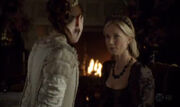
Catherine discussing Protestantism with her sister, Anne.
Catherine was a graceful and intelligent woman; who always tried to be guided by her conscience and make the very best she could out of whatever situation she was in. Thus; she proved to be a respected queen; with the exception of conservative courtiers and clergymen like Bishop Gardiner; who were resentful of her. She also was a very religious woman; despite her fears stemming from the knowledge of what had happened to Henry's previous wives as well as her passionate love for Thomas Seymour, she ultimately sacrificed her private feelings to do god's supposed will and marry a king. But her religious passion had a negative aspect; it caused her to occasionally loathe herself and in turn led her to list her sins in a journal. Although she was a reformist, she was realistic enough to refuse to challenge Henry on his policies or display her faith because she recognized that it was dangerous, especially when she recalled the fates of more outspoken Protestants like Anne Boleyn, Thomas Cromwell and Anne Askew.
Above all, Catherine was a compassionate, kind-hearted woman; who loved all three of her step-children as if they had been her own and did everything in her power to make their lives better. In fact, it was because of her efforts that thery were able to - for a time - lead the life of a true united family, living at court together and becoming more intimate with their father. Thus; she was the one step-mother; who was truly beloved by all three of Henry's children, although her relationship with Mary became somewhat strained later on; due to their differences in opinions over religion.
Although Catherine did not love Henry as she did Thomas Seymour and it was evident how she genuinely cared more for her step-children than she; ever did for him, but Catherine still loved Henry in her own way - whenever he was ill, she always insisted on nursing him personally and did so gently; without any complaints. When Henry bid her and his children farewell, and revealed as to how he had already made provisions that assured her of a rich and comfortable life; even after he had died, the usually gracious Catherine openly broke down, a testament of sorts that she did have a true affection of sorts for him in her way, although it was not romantic love.
Physical appearance[]
Catherine is an attractive woman; with long blonde hair and blue eyes, and although she is not truly youthful, she carried herself; with unpretentious grace. She wore the standard crowns, jewellery and dresses of the english queens.
Quotes[]
- Thomas Seymour: "You would not like to be Queen of England?" Katherine: "NO! For heaven's sake, you know what happens to his queens, everyone knows what happens! Oh, Thomas, I...I'm afraid."
- Katherine: "Come here, young lady, and let me hug you. I expect great things of you, and I know I shall not be dissapointed." Elizabeth: "I hope not." Katherine: "Now, off to bed, sweet girl."
- Katherine: "Lady Ashley, a moment... I believe that I can trust you; I think that your family are reformers?" Lady Ashley, Elizabeth's governess: "Yes, madam." Katherine: "Lady Elizabeth's mother, Anne Boleyn, was also a Lutheran and a reformer... I suppose it is my duty, therefore, to bring the daughter up in the mother's faith. Would you have any objection to that, Lady Ashley?" Lady Ashley: "None, your Majesty. I should be proud to help the Princess thus honor the memory of her mother, whose life and whose faith too many so easily disparrage." Katherine: "Good. Then, I will appoint as her tutor Roger Asham; he is also one of us. You may go... Oh, and Lady Ashley- this conversation never happened (Lady Ashley nods). Good night." Lady Ashley: "Good night, Your Majesty."
- "Do you suppose that it is a bad thing that everyone in England should be able to read the Bible for themselves?"
- "Anne, you know I never wanted to be the Queen- but, since I am, I may as well use what influence I have to further the cause I believe in... the cause of the Reformation."
- "Should I play the coward?"
Trivia[]
- Catherine Parr is the second oldest wife of Henry Tudor VIII; second only to Catherine of Aragon.
